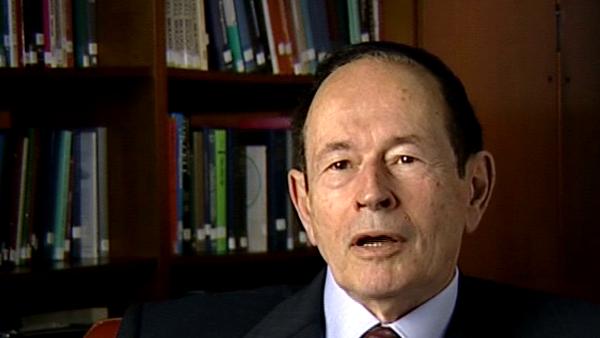NEXT STORY

The institutional situation at the Rockefeller Institute
RELATED STORIES

NEXT STORY

The institutional situation at the Rockefeller Institute
RELATED STORIES



The problem of the Bence Jones proteins went as follows: at a certain point we knew that there were chains – we knew they were linked by disulphide bonds. We didn't really have a very good method of fractionating them except the starch gel, which wasn't good for preparative purposes, nonetheless. One day I said to Joe... and, by the way, we differ a little on this story, but I don't think basically... I said, 'I'm going to make Bence Jones proteins out of your light chains.' We had been fractionating these things and got light and heavy chains – the light chain about 20,000, the heavy chain about 55. And he said, 'Well, you... that's the craziest thing I ever heard.' We set it up, we cooked it, and, by golly, we got the Bence Jones phenomenon and I damn near dropped the tube. And at that moment I had a real epiphany, and so did he. I remember his saying something like, 'Well, now we see everything', and my response was, 'Yeah, dimly.'
But we did see now something really extraordinary – namely that Bence Jones proteins were, in fact, in the case of the cancer, a result of making huge amounts of the myeloma protein which was the whole thing that had the disulphide bonded structure and 150,000 molecular weight; they were extra chains, they were small enough to go out into your urine because they were filtered by the kidney. And in fact that was the end of the Bence Jones story. We... we found out the answer to Watson's question: what is it? Bence Jones protein is a light chain of an antibody. What do you mean an antibody? Well, the antibody was not instructed – you just had huge numbers of them – and that's why, for instance, different myeloma patients had different mobilities for their light chains. Well, then followed the fact that we had solved the size problem to a degree, the heterogeneity problem because of the fact of an accident of nature, and a third problem, the specificity problem, by having chemical results that fit Macfarlane Burnet's theory. So that was all groovy, but then the next thing was, you know, now we had to sit down and do the whole structure. And that's a totally different episode because it involved being joined by remarkably talented people – for instance, Bruce Cunningham, who was key; Einar Gall who is now the Director of The Neurosciences Institute, the Research Director; and Myron Waxdal and Paul Gottleib, and we had a little cadre of people who said, 'Okay, now we're going to go after the whole darn structure.' So that began another episode.
US biologist Gerald Edelman (1929-2014) successfully constructed a precise model of an antibody, a protein used by the body to neutralise harmful bacteria or viruses and it was this work that won him the Nobel Prize in Physiology or Medicine in 1972 jointly with Rodney R Porter. He then turned his attention to neuroscience, focusing on neural Darwinism, an influential theory of brain function.
Title: An epiphany working on Bence Jones protein
Listeners: Ralph J. Greenspan
Dr. Greenspan has worked on the genetic and neurobiological basis of behavior in fruit flies (Drosophila melanogaster) almost since the inception of the field, studying with one of its founders, Jeffery Hall, at Brandeis University in Massachusetts, where he received his Ph.D. in biology in 1979. He subsequently taught and conducted research at Princeton University and New York University where he ran the W.M. Keck Laboratory of Molecular Neurobiology, relocating to San Diego in 1997 to become a Senior Fellow in Experimental Neurobiology at The Neurosciences Institute. Dr. Greenspan’s research accomplishments include studies of physiological and behavioral consequences of mutations in a neurotransmitter system affecting one of the brain's principal chemical signals, studies making highly localized genetic alterations in the nervous system to alter behavior, molecular identification of genes causing naturally occurring variation in behavior, and the demonstration that the fly has sleep-like and attention-like behavior similar to that of mammals. Dr. Greenspan has been awarded fellowships from the Helen Hay Whitney Foundation, the Searle Scholars Program, the McKnight Foundation, the Sloan Foundation and the Klingenstein Foundation. In addition to authoring research papers in journals such as "Science", "Nature", "Cell", "Neuron", and "Current Biology", he is also author of an article on the subject of genes and behavior for "Scientific American" and several books, including "Genetic Neurobiology" with Jeffrey Hall and William Harris, "Flexibility and Constraint in Behavioral Systems" with C.P. Kyriacou, and "Fly Pushing: The Theory and Practice of Drosophila Genetics", which has become a standard work in all fruit fly laboratories.
Tags: Joe Gally, Macfarlane Burnet, Bruce Cunningham, Einar Gall, Myron Waxdal, Paul Gottleib
Duration: 2 minutes, 39 seconds
Date story recorded: July 2005
Date story went live: 24 January 2008